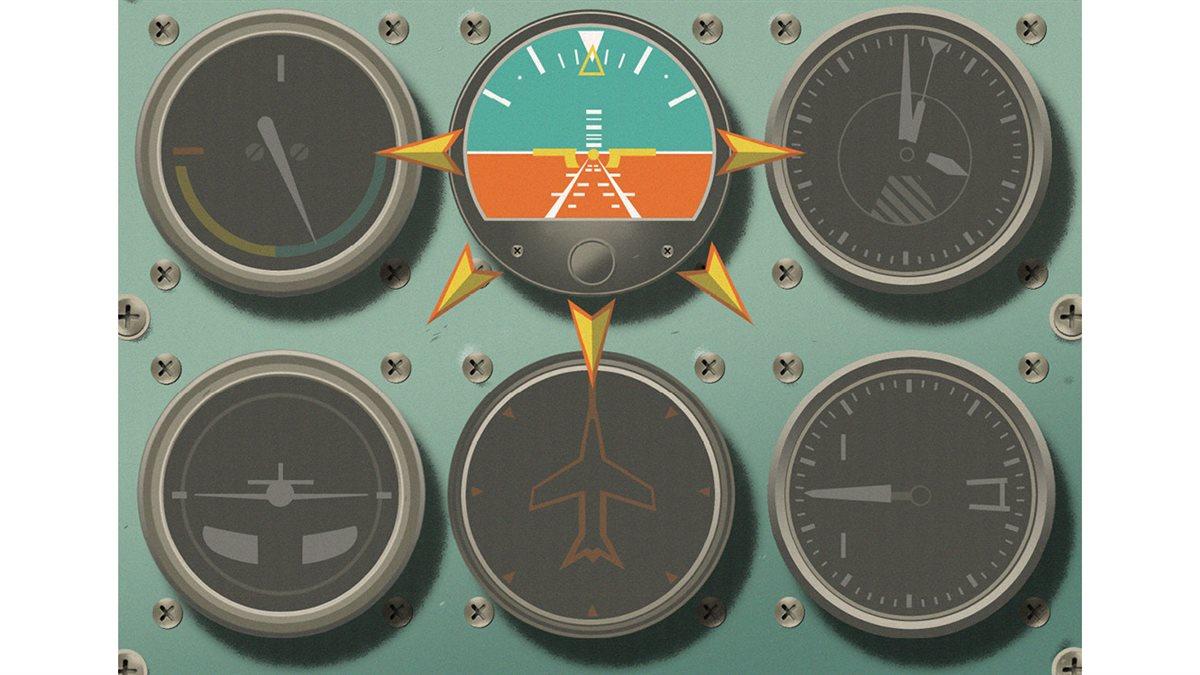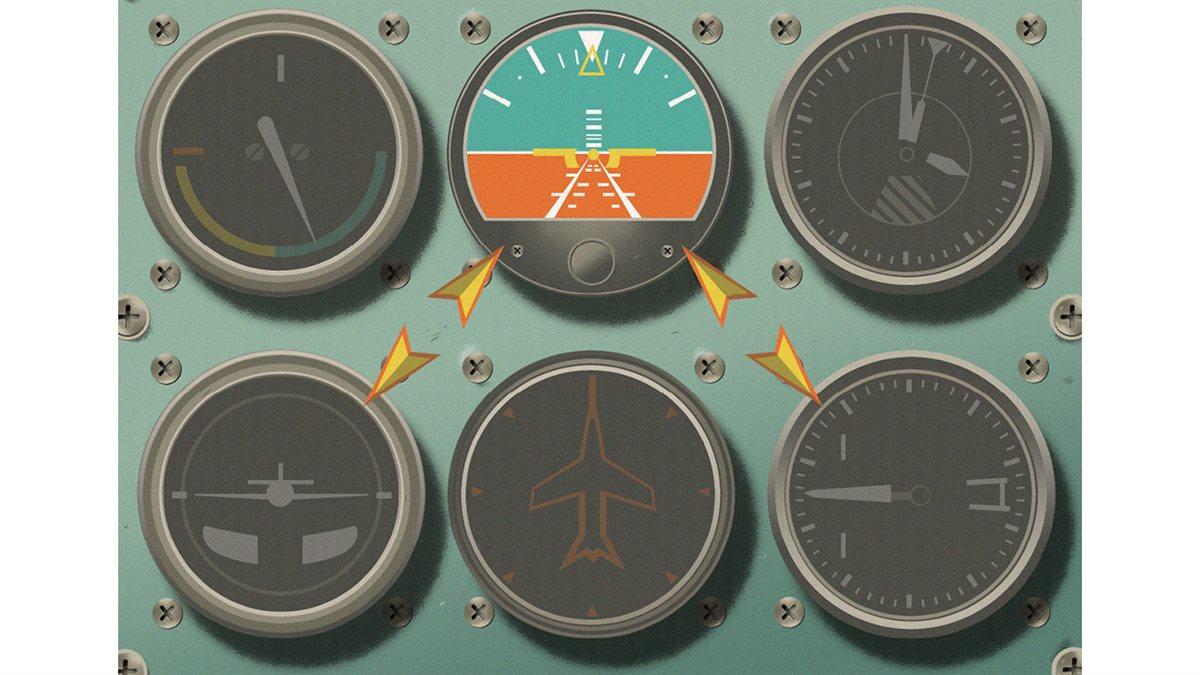Gray out
If the unthinkable occurs, pause to wind your watch

I’ve decided to share that experience, not to talk about what you can do to avoid getting into the same pickle I did—there’s more than enough already written about getting better at reading weather, setting personal minimums, and avoiding get-there-itis—but to give you some tips about what to do if it happens to you, too.
The story starts on the ramp. I picked up my airplane following maintenance and was going to ferry it back to our home base, a short hop of about 50 nautical miles. It was bright and sunny at the departure airport. Cool and dead calm. My destination was reporting clear as well, but there was a low-lying band of clouds between the two. I stood at the edge of the apron for several minutes scowling at that distant band of misty gray, willing it (with no luck) to either rise or dissipate.
From my vantage point, I really couldn’t tell how much room there was between the ground and the bottom of the cloud bank, and I finally decided there was no harm in going up to have a look. If I couldn’t slip comfortably and legally under the cloud bank, I could always turn back and call it a day. Either I’d get back home or get in a short flight, so there was nothing to lose.
I took off and flew toward the cloud bank. At first there was plenty of room to navigate between the ground and the clouds, and a reassuring glance out my back windows showed lots of sunshine to retreat to if things changed. But as I went along, the ceiling dropped closer and closer to the terrain. Coming over a rise, I could see that the clouds dropped all the way to the ground ahead of me. But a little to the north, the ceiling appeared higher. I made a run for the bright spot, dropped into a wide canyon, and began to fly down it. But the gray mist drifted slowly down, down, down—and I knew it was time to throw in the towel and head back to the bright sunshine behind my tail.
I executed a 180-degree turn. About a third of the way through the turn, the world disappeared.
It was as if all my windows had instantly fogged over. My wings disappeared into the seamless gray mist. Oddly, even the heavy drone of the Continental engine seemed to fade to nothing in this netherworld devoid of color, texture, and light. It was as if I had been plucked from my airplane and deposited into an alternate, empty universe.
My first reaction was disbelief. How could this have happened? I had plenty of room to maneuver! How could the ceiling have dropped so fast? Next, a lightning bolt of raw fear shot though me. The ground was close, the canyon walls higher than my flight path. Statistics on VFR to IMC crashes were the only things I could see: Grim rows of numbers tumbling across my inner eye.
In seconds, I was disoriented. I felt like I was in a diving turn to the left, but when I looked at the panel I discovered I had placed myself into a steep climbing turn to the right. Fear of controlled flight into terrain caused me to pull back on the yoke without realizing what I was doing, and as I was frantically scanning outside for a break in the grey mist that had enveloped me, I wasn’t as focused on the panel as I should have been.
In seconds, I was DISORIENTED.My mind was racing through my options: Try to climb out? Try to turn back? Stay straight and level? In a more powerful airplane, I would have tried to climb out on top, but I knew I didn’t have the power to beat the terrain. Turning back would just lead me into the yet-lower ceiling, keeping me blind longer. Not sure where I was in my turn, I knew I might fly right into the valley wall. I crossed my fingers, cut the power, leveled the wings, and started to drift downward, hoping to break out before I slammed into the ground.
Luckily, the clouds released me shortly after capturing me. The mist brightened, first giving me back my wings, and then dissolving to reveal the deep green of juniper and piñon pine below. Like a shot from a cannon, I roared up the valley and out into the sunshine again.
Happy ending. But it was stunning to me how quickly, once in the clouds, I didn’t know up from down, fast from slow, turning from level. I’ve read a hundred times about crashes from VFR to IMC and have always thought, Well, why didn’t that idiot just fly by instruments? But it’s not as easy to do as it sounds, especially when you’re not prepared for it.
We can talk all day long about my decision chain gone awry, but that’s not the point. And although we should get better at reading weather, have personal minimums, and be aware of get-there-itis, we also need a tool kit for surviving if you find yourself flying in a seamless cocoon devoid of color, texture, and light. Because it can happen. To me. To you. To any pilot who flies.
Having been there once, and hoping never to be there again, I nevertheless now have a plan in mind should I ever find myself in the same pickle in the future. After all, lightning really does sometimes strike the same place twice.
And the first thing I’ll do if this ever happens again is wind my watch.
Don’t forget that most airplanes behave themselves pretty well when left alone for a minute or two. The same is not true of pilots.Yep. That’s some of the oldest advice in the world for aviation emergencies. Of course I’m speaking figuratively here. It’s simply a way of saying that the first thing you should do in most emergencies is nothing; because I promise you that anything else that you do when instantly transported into this frightening dimension of nothingness will likely be the wrong thing. You will be scared—terrified—and “winding your watch” is a way of taking a breath. Settling the fear. Clearing your mind. Getting ready for the challenge.
Don’t forget that most airplanes behave themselves pretty well when left alone for a minute or two. The same is not true of pilots.
While you are “winding your watch,” tell yourself that there is no truth left in the world but the instruments. Your body will lie to you, and it will lie to you with a speed that is incomprehensible—until you’ve actually experienced it. I began to lose control in mere seconds. You might, too. And research shows that’s commonplace.
OK. Your watch is wound. Now what? In studies of simulated emergency situations, noninstrument-rated pilots—as well as rusty rated ones—have been shown to have a poor ability to scan and deal with all of the flight instruments properly. To avoid cockpit overload, it’s actually safer to focus keenly on one, rather than to scan them all poorly. So which instrument should you focus your keenest attention on? Your best friend on the instrument panel is the attitude indicator. It’s actually possible, at least for a time, to fly an airplane using just that one instrument.
Once you are sure the airplane has stayed stable—or been returned to stability—work the problem. What is the best way out of the situation you’re in? If you need to navigate, do it like a baby: small steps. Keep turns and altitude changes small: No more than 10 degrees for turns. Make a turn a few legs at a time.
Remember that it’s OK to call for help. This is an emergency—one perhaps of your own making, but if you’re in the clouds, your life is on the line—and help is a radio call away. Don’t be afraid to ask for it.
Don’t get me wrong. Prevention is 90 percent of the cure, and we should do all we can to avoid flying VFR into IMC. But I think we also need to acknowledge that sometimes things happen, and we need to be prepared.
And you can do more than just be prepared mentally. You can practice in advance, too. Whether or not you have an instrument rating, call up your favorite CFI and periodically log some “hood” time—flying by instruments wearing a view-limiting device that simulates being in the clouds. Having been under both a hood and in a cloud, I can assure you that one doesn’t prepare you very well for the other, but the hood will help you develop confidence in your ability to control the airplane by reference to instruments alone. Practice both full scans, and with the help of some instrument covers, practice flying by just the attitude indictor alone.
And if you end up with your head—and your airplane—in the clouds, just pretend you’re wearing a hood.
After you wind your watch.
A

B

C

Trust, but verify
Instrument cross-check is a fundamental IFR skill
When flying solely by reference to instruments, it’s easy to fixate on one flight instrument or scan the panel without knowing what to look for. Developing the proper scan enables a pilot to verify that the information from one instrument is correct, and to adjust the aircraft’s attitude as flight conditions change. The Instrument Flying Handbook identifies these three methods of instrument scanning:
A. Selected radial cross-check
This scan radiates out from the attitude indicator to the five other flight instruments. A pilot spends 80 to 90 percent of the time looking at the attitude indicator.
B. Inverted V cross-check
The scan goes from the attitude indicator to the turn coordinator, back to the attitude indicator, and to the vertical speed indicator.
C. Rectangular cross-check
This scan goes in a rectangular path, giving equal weight to information from each instrument.
The three hours of instrument training required for the private pilot certificate will introduce you to the principles of basic attitude instrument flying, but don’t take that as license to fly in the clouds. Flight into instrument meteorological conditions by a pilot who is not instrument rated—or even an instrument-rated pilot whose skills have eroded—is an emergency. —Sarah Deener
For more information on preventing VFR into IMC accidents, see the AOPA Air Safety Institute’s online course Weather Wise: VFR into IMC.



